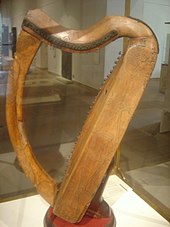Harp
The harp, or clarsach, has a long and ancient history in Scotland, and was regarded as the national instrument until it was replaced with the Highland bagpipes in the 15th century. Stone carvings in the East of Scotland support the theory that the harp was present in Pictish Scotland well before the 9th century and may have been the original ancestor of the modern European harp and even formed the basis for Scottish pibroch, the folk bagpipe tradition.
Barring illustrations of harps in the 9th century Utrecht psalter, only thirteen depictions exist in Europe of any triangular chordophone harp pre-11th century, and all thirteen of them come from Scotland. Pictish harps were strung from horsehair. The instruments apparently spread south to the Anglo-Saxons, who commonly used gut strings, and then west to the Gaels of the Highlands and to Ireland. The earliest Irish word for a harp is in fact Cruit, a word which strongly suggests a Pictish provenance for the instrument. The surname MacWhirter, mac a' chruiteir, means son of the harpist, and is common throughout Scotland, but particularly in Carrick and Galloway.
The Clàrsach (Gd.) or Cláirseach (Ga.) is the name given to the wire-strung harp of either Scotland or Ireland. The word begins to appear by the end of the 14th century. Until the end of the Middle Ages it was the most popular musical instrument in Scotland, and harpers were among the most prestigious cultural figures in the courts of Irish/Scottish chieftains and Scottish kings and earls. In both countries, harpers enjoyed special rights and played a crucial part in ceremonial occasions such as coronations and poetic bardic recitals. The Kings of Scotland employed harpers until the end of the Middle Ages, and they feature prominently in royal iconography. Several Clarsach players were noted at the Battle of the Standard (1138), and when Alexander III (died 1286) visited London in 1278, his court minstrels were with him, payments were made to Elyas the "King of Scotland's harper."
Three medieval Gaelic harps survived into the modern period, two from Scotland (the Queen Mary Harp and the Lamont Harp) and one in Ireland (the Brian Boru harp), although artistic evidence suggests that all three were probably made in the western Highlands.
The playing of this Gaelic harp with wire strings died out in Scotland in the 18th century and in Ireland in the early 19th century. As part of the late 19th century Gaelic revival, the instruments used differed greatly from the old wire-strung harps. The new instruments had gut strings, and their construction and playing style was based on the larger orchestral pedal harp. Nonetheless the name "clàrsach" was and is still used in Scotland today to describe these new instruments. The modern gut-strung clàrsach has thousands of players, both in Scotland and Ireland, as well as North America and elsewhere. The 1931 formation of the Clarsach Society kickstarted the modern harp renaissance. Recent harp players include Savourna Stevenson, Maggie MacInnes, and the band Sileas. Notable events include the Edinburgh International Harp Festival, which recently staged the world record for the largest number of harpists to play at the same time.



0 Comments:
Post a Comment
Subscribe to Post Comments [Atom]
<< Home